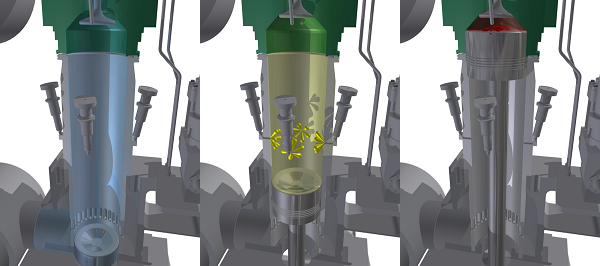
Low pressure 2 stroke dual fuel
Experience of dual fuel engines have previously mostly been related to four stroke engines but have also been developed for larger two stroke engines. The Wärtsilä 50 RT-flex DF relies on low pressure fuel injection to the cylinder during the early part of compression. This allows for relatively low injection pressures (<10 bar) and consequently a less complex and a less expensive fuel injection system.
As the fuel injection occurs after the air inlet ports are closed by the cylinder the air supply should not be affected by the corrosive properties of methanol. A potential problem is that it might be hard to achieve a homogeneous fuel/air mixture in the cylinder before ignition.

Figure 10: 2-stroke Otto combustion: 1) Scavenging, air inlet in bottom of cylinder is open and exhausts are vented through the open top valve. 2) Methanol is injected to the cylinder during the early parts of combustion. 3) The methanol-air mixture in the cylinder is ignited by a pilot injection of diesel at TDC.
As with similar technologies for four stroke engines, the fuel mixture in the cylinder is ignited by an injection of diesel at TDC. According to Wärtsilä, the amount of pilot diesel is significantly lower compared to the high pressure diesel concept. At full load the amount of pilot diesel is about 1 % of the total fuel energy and stays constant through the load range. Knocking is prevented by lowering the maximal output from the engine by 15-20 %.
When operating on LNG emissions of NOX meet Tier III requirements and methanol operation is likely to meet it as well.